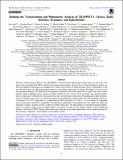Notice
This is not the latest version of this item. The latest version can be found at:https://dspace.mit.edu/handle/1721.1/135525.2
Refining the Transit-timing and Photometric Analysis of TRAPPIST-1: Masses, Radii, Densities, Dynamics, and Ephemerides
| dc.date.accessioned | 2021-10-27T20:23:50Z | |
| dc.date.available | 2021-10-27T20:23:50Z | |
| dc.date.issued | 2021 | |
| dc.identifier.uri | https://hdl.handle.net/1721.1/135525 | |
| dc.description.abstract | We have collected transit times for the TRAPPIST-1 system with the Spitzer Space Telescope over four years. We add to these ground-based, HST and K2 transit time measurements, and revisit an N-body dynamical analysis of the seven-planet system using our complete set of times from which we refine the mass ratios of the planets to the star. We next carry out a photodynamical analysis of the Spitzer light curves to derive the density of the host star and the planet densities. We find that all seven planets' densities may be described with a single rocky mass-radius relation which is depleted in iron relative to Earth, with Fe 21 wt% versus 32 wt% for Earth, and otherwise Earth-like in composition. Alternatively, the planets may have an Earth-like composition, but enhanced in light elements, such as a surface water layer or a core-free structure with oxidized iron in the mantle. We measure planet masses to a precision of 3-5%, equivalent to a radial-velocity (RV) precision of 2.5 cm/sec, or two orders of magnitude more precise than current RV capabilities. We find the eccentricities of the planets are very small; the orbits are extremely coplanar; and the system is stable on 10 Myr timescales. We find evidence of infrequent timing outliers which we cannot explain with an eighth planet; we instead account for the outliers using a robust likelihood function. We forecast JWST timing observations, and speculate on possible implications of the planet densities for the formation, migration and evolution of the planet system. | |
| dc.language.iso | en | |
| dc.publisher | American Astronomical Society | |
| dc.relation.isversionof | 10.3847/PSJ/ABD022 | |
| dc.rights | Creative Commons Attribution 4.0 International license | |
| dc.rights.uri | https://creativecommons.org/licenses/by/4.0/ | |
| dc.source | IOP Publishing | |
| dc.title | Refining the Transit-timing and Photometric Analysis of TRAPPIST-1: Masses, Radii, Densities, Dynamics, and Ephemerides | |
| dc.type | Article | |
| dc.relation.journal | The Planetary Science Journal | |
| dc.eprint.version | Final published version | |
| dc.type.uri | http://purl.org/eprint/type/JournalArticle | |
| eprint.status | http://purl.org/eprint/status/PeerReviewed | |
| dc.date.updated | 2021-09-15T16:22:58Z | |
| dspace.orderedauthors | Agol, E; Dorn, C; Grimm, SL; Turbet, M; Ducrot, E; Delrez, L; Gillon, M; Demory, B-O; Burdanov, A; Barkaoui, K; Benkhaldoun, Z; Bolmont, E; Burgasser, A; Carey, S; de Wit, J; Fabrycky, D; Foreman-Mackey, D; Haldemann, J; Hernandez, DM; Ingalls, J; Jehin, E; Langford, Z; Leconte, J; Lederer, SM; Luger, R; Malhotra, R; Meadows, VS; Morris, BM; Pozuelos, FJ; Queloz, D; Raymond, SN; Selsis, F; Sestovic, M; Triaud, AHMJ; Grootel, VV | |
| dspace.date.submission | 2021-09-15T16:22:59Z | |
| mit.journal.volume | 2 | |
| mit.journal.issue | 1 | |
| mit.license | PUBLISHER_CC | |
| mit.metadata.status | Authority Work and Publication Information Needed |
